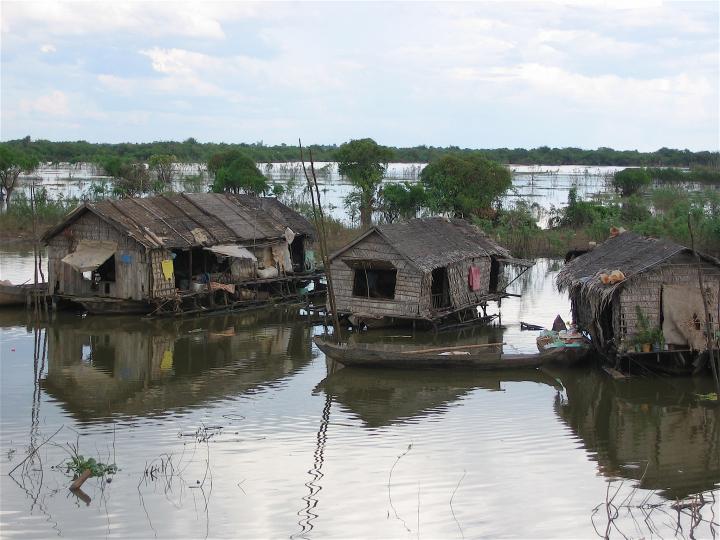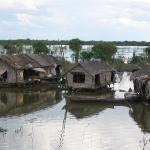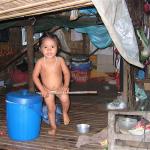New Hope for Lake Ton Le Sap
One afternoon during our visit to Siem Reap Cambodia we went boating on Lake Ton Le Sap. My eyes were drawn to one unforgettable scene after another. We passed houses on stilts and straw huts floating in the water. The lake swarmed with dozens of rickety wooden boats with rusty motors. There were people washing dishes in the lake, doing laundry, swimming, bathing, cleaning vegetables, brushing their teeth and going to the washroom. We saw men throwing out fishing nets and women cutting up and salting the resulting catch. Our boat docked at a village along the shore. Twenty-year-old trucks were pulled up haphazardly along the beach waiting to take loads of fish to market. People lived in little wooden lean- tos. Each makeshift shelter was a jumble of belongings. Sleeping mats were spread out on the slatted floors. Men lay snoozing on these mats while women sat at their sides fanning them. Plastic pails, tin cans and earthenware jars held drinking water, gasoline, garbage and the family’s storehouse of rice. Bowls of food and chopsticks sat on tables made from cross sections of tree trunks. An odd assortment of boat batteries, baskets filled with clothing, fishing tackle, blankets, gas burners for cooking, foodstuffs, and usually a small television set completed the contents of the homes. The lean tos had bamboo, reed or grass roofs and walls formed from tarps or sheets of plastic. These dwellings had no front doors so you could see right inside each one. Most of the toddlers ran around without any clothes in the stifling heat. Older kids were dressed in torn and dirty clothing and begged us for money, gum, pens, our watches and jewellery. Although many of the children had rotting teeth and runny noses their faces and hair were washed and clean. The little girls had pierced ears with tiny gold hoops and dark, beautiful eyes. The women wore colourful sarongs and the elderly ladies had their heads wrapped up in loose fitting turbans. We visited during the annual water festival. This is when the local people celebrate the receding of the floodwaters on Lake Ton Le Sap. The level of the lake begins to rise each June and eventually increases the depth of the lake by some nine meters. 116 Cambodian villages along the lake rely on it for a living. During the flood season their primary source of income is fishing. In November the waters start to go down revealing rich soil just perfect for rice planting. Farming is how the nearly 2 million people who reside on the lake earn money from December till May. Apparently just a few years ago Lake Ton Le Sap was a military zone with fisherman and farmers carrying automatic weapons patrolling their fields and fishing grounds. Fish from the lake and timber stocks in the nearby forest were being harvested unsustainably. 80% of the people earned less than $150 US a year while a corrupt bureaucracy pocketed bribes and took most of the profits. With the help of international aid, community based natural resource organizations have been formed in most Cambodian villages on Lake Ton Le Sap. They have begun using a democratic process to establish fishing and lumber rights. Over fishing and illegal fishing are becoming less prevalent and alternate fuels like gas and coal are replacing wood, thus preserving the shrinking forests. Things are changing on Lake Ton Se Sap. Hopefully in the future housing will improve and schools and clinics will be built. I’d love to visit again and bear witness to more new beginnings in this unforgettable place.
 ThingsAsian
ThingsAsian




















